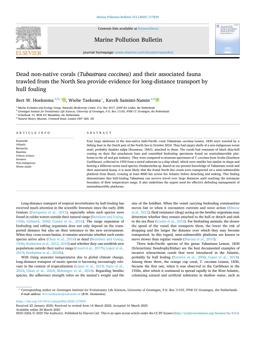2025-03-20
Dead non-native corals (Tubastraea coccinea) and their associated fauna trawled from the North Sea provide evidence for long-distance transport by hull fouling
Publication
Publication
Marine Pollution Bulletin , Volume 215 - Issue 117839
Four large skeletons of the non-native Indo-Pacific coral Tubastraea coccinea Lesson, 1830 were trawled by a fishing boat in the Dutch part of the North Sea in October 2024. They had empty shells of a non-indigenous worm snail, probably Eualetes tulipa (Rousseau, 1843), attached to them. The corals had remnants of black ship-hull coating on their flat attachment base and resembled biofouling specimens found on semisubmersible platforms in the oil and gas industry. They were compared to museum specimens of T. coccinea from Aruba (Southern Caribbean), collected in 1955 from a metal substrate in a ship wharf, which were smaller but similar in shape and hosting a different worm snail species, Petalaconchus sp. Based on our present knowledge of Tubastraea corals and their associated fauna, it is most likely that the found North Sea corals were transported on a semi-submersible platform from Brazil, crossing at least 8000 km across the Atlantic before detaching and sinking. This finding demonstrates that hull-fouling Tubastraea can survive travel over large distances until reaching the minimum boundary of their temperature range. It also underlines the urgent need for effective defouling management of semisubmersible platforms.
| Additional Metadata | |
|---|---|
| , , , , , , | |
| doi.org/10.1016/j.marpolbul.2025.117839 | |
| Marine Pollution Bulletin | |
| Released under the CC-BY 4.0 ("Attribution 4.0 International") License | |
| Organisation | Staff publications |
|
Hoeksema, B., Taekema, Wiebe, & Samimi-Namin, K. (2025). Dead non-native corals (Tubastraea coccinea) and their associated fauna trawled from the North Sea provide evidence for long-distance transport by hull fouling. Marine Pollution Bulletin, 215(117839). doi:10.1016/j.marpolbul.2025.117839 |
|
